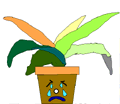How to transplant |

' Please change the compost now ! '
|
|
' My roots are going to berotted.' ' Please change the compost now ! ' |
|
|
When we transplant ?Transplanting for Paphs should be faster
than we expected basicaly.
|
The materials for transplanting(1) sphagnum moss
|
|
When you grow Paphiopedilum in the same compost without transplanting, the condition in the compost would be worse and cause the roots to be rotted and be died. For example, when you grow Paph in shagnum moss, not only the moss decayed but also the good grows of roots would make close for watering and airation and further more, the excretion from roots would be accumulated in the compost. In these case, you have to transplant the Paph as fasat as possible. But when you grow Paphs in your room , not in green house, the transplanting season should be limited in a year. It must be in spring, May , just after flowering. In this season, the plants are just going to grow in spring. But don't transplant some Paphs who have flower and expanding the stem for summer. Don't forget that you have to transplant the Paphs who have bigun to grow. In summer, you had better not transplnt because it is too hot and the plants are consumed by the high temperature. In autumn, it would be good season to transplant because they are going to grow again after hot summer. But it must be very dengerous to transplant for the beginners because Paphs will grow for a short period and sleep soon. But for the summer flower Paphs, you must transplant in this season sometimes. Of course, you never transplant in winter because they are sleeping. When you transplant, you take the plant off from the pot and clean up their roots including taking off their died roots. After washing by water , you had better treat the plants by medicine of an insecticide and a germicide. And then you transplant with a new compost. In this time, be careful not to hurt their roos, especially new roots with white and yellow points. Paphiopedilum have not so many roots and the roots will be much easier to break and to come off than the roots of other orchids. When the plants grow well and their roots looks cramped、you use the bigger pot. In many vase, you use the same size or the smaller size incase of theplants comming small. |
|
|
|
Mixed Materials |
|
(A) |
(B) |
(C) |
|
| (a) Hydrophobic materials | |||
| Volcano stones or Hyuga stone |
4~5 |
3~4 |
|
| Baked Aka-Tama |
3~4 |
||
| Ceraton |
2 |
||
| (b) Hydrophilic materials | |||
| bark or tips of coconut |
5~4 |
4~3 |
4~3 |
| (c) Ion exchanger | |||
| Activated charcoal or zeolite |
1 |
1 |
|
| Native ceramics |
1 |
| (A) is used in general, (B) is recomended generaly by me, (C) is used materilas by me now. |
| (A)The mixture for general use |
| (B)The mixture I recommend for general using baked Aka-Tama. |
| (C)The mixture I'm using now. I prefer native ceramics, Silica. |
| Note: About native ceramics, I have special writings in other site. Please visit the site if you are interested in. Sorry it is in Japanese only now. In near future, I'll translate in English. |
|
|
|
|
Continue to The control of Pests & Desease |
Back to Index |